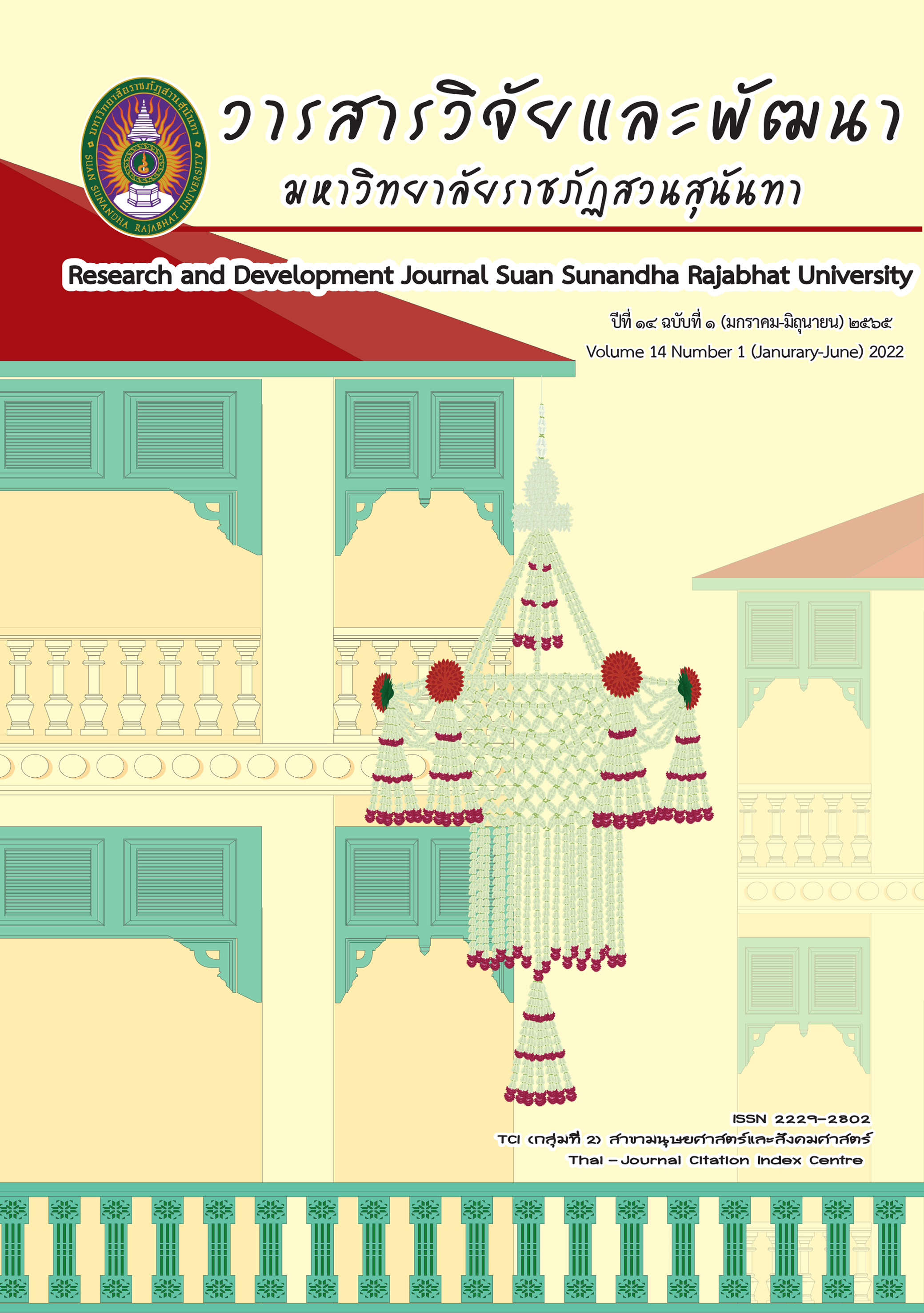Thailand's Constitution Development
DOI:
https://doi.org/10.53848/irdssru.v14i1.254108คำสำคัญ:
Constitution of the Kingdom of Thailand, Thailand’s Constitution, Constitutional History of Thailandบทคัดย่อ
Since 1932 Thailand has issued 20 charters and constitutions, many adopted following military coups; which reflects a high degree of political instability. After each successful coup the newly emergent military leaders abrogated existing constitutions and promulgated new ones. All of Thailand's charters and constitutions have recognized a unified kingdom with a constitutional monarchy, but with different balances of power between the various branches of government. Most Thai governments have stipulated parliamentary systems. Both unicameral and bicameral parliaments have been used, and members of parliament have in the past been both elected as well as appointed. The King of Thailand has little direct power under the constitution but he is nevertheless a strong symbol of national identity and unity (Chanrochanakit, 2015).
เอกสารอ้างอิง
Achirasena, A. (2022). The Right of the Royal Family Members to Hold Political Office according to Thai Constitutional Court Ruling. Chulalongkorn Law Journal, 40(1 (In Thai)).
Albritton, R. B., & Bureekul, T. (2004). Developing Democracy under a New Constitution in Thailand. Asian Barometer Project Office, National Taiwan University and Academia Sinica.
Aphornsuvan, T. (2001). The Search for Order: Constitutions and Human Rights in Thai Political History. Faculty of Liberal Arts, Thammasat University.
Chanrochanakit, B. (2015). Constitution of the Kingdom of Thailand: History and Matters. King Prajadhipok’s Institute Journal (In Thai).
Freedom Thing. (2011). History of Thailand’s Constitution. Retrieved from http://freedom-thing.blogspot.com/2011/10/blog-post.html (In Thai)
Hays, J. (2014). Constitution of Thailand: The 2007 Constitution, Older Versions, Laws and Rights. Retrieved from http://factsanddetails.com/southeast-asia/Thailand/sub5_8f/entry-3275.html
Head, J. (2017). Thailand’s Constitution: New Era, New Uncertainties. Retrieved from https://www.bbc.com/news/world-asia-39499485
Human Rights Watch. (2014). Thailand: Interim Constitution Provides Sweeping Powers. Retrieved from https://www.hrw.org/news/2014/07/24/thailand-interim-constitution-provides-sweeping-powers
Iampriwan, W. (2004). 72 Years of the Constitutional System of Thailand’s Development: Failure at Democratic Development. King Prajadhipok’s Institute Journal, 2(2 (In Thai)).
International Labour Organization. (2007). Constitution of the Kingdom of Thailand 2007. Retrieved from http://www.ilo.org/wcmsp5/groups/public/@ed_protect/@protrav/@ilo_aids/documents/legaldocument/wcms_117898.pdf
Janreung, S. (2009). Constitution of Thailand. Education Law Journal, Law Department. Surin, Thailand: Faculty of Humanity and Social Science, Surindra Rajabhat University.
Jory, P. (2012). Thailand’s Constitutional Reform in Changing Times. Retrieved from http://www.eastasiaforum.org/2012/03/27/thailand-s-constitutional-reform-in-changing-times
Kasetsiri, C. (2020). Thailand Constitution 1946 and Struggle Against Authoritarianism. Pridi Banomyong Institute (In Thai).
Kasetsiri, C. (2021). The Popular Uprising of 14 October 1973 and People’s Victory against Oligachy. Retrieved from https://www.silpa-mag.com/history/article_40175 (In Thai)
Khamphothong, R. (2021). Ideal Constitution: Principles and Will of the 1932 People’s Party. Retrieved from https://www.silpa-mag.com/history/article_69349 (In Thai)
Khongbenjapush, K. (2018). Illegitimate Succession of Political Power. Law and Local Society Journal, Suratthani Rajabhat University, 2(2 (In Thai)).
Khonsurin. (2010). Retrace the 6 Boworadet Rebellion. Retrieved from http://www.baanmaha.com/community/thread35963.html (In Thai)
Law to Know. (2009). Exercising of Power regarding the Article 17 of the Thai Constitution. Retrieved from ttp://lawtoknow.blogspot.com/2009/11/17.html (In Thai)
McCargo, D. (2002). Reforming Thai Politics. NIAS Press: Nordic Institute of Asian Studies.
Merieau, E. (2019). The 1932 Compromise Constitution: Matrix of Thailand’s Permanent Constitutional Instability. Oxford, UK: Hart Publishing.
People’s Daily. (2006). New Senate election casts shadow on political prospect in Thailand. Retrieved from http://en.people.cn/200604/21/eng20060421_260158.html
Prachathai. (2014). Revealing the 2014 Interim Constitution. Retrieved from https://prachatai.com/journal/2014/07/54695 (In Thai)
Preechasinlapakun, S. (2013). Dynamics and Institutionalization of Coups in the Thai Constitution. Institute of Developing Economies. Japan External Trade Organization.
UNESCO. (2019). Thailand’s Constitution of 2017. Retrieved from http://www.unesco.org/education/edurights/media/docs/e60903d5f4cb9278215dc0c231ac42a4da007434.pdf
ดาวน์โหลด
เผยแพร่แล้ว
รูปแบบการอ้างอิง
ฉบับ
ประเภทบทความ
สัญญาอนุญาต
ลิขสิทธิ์ (c) 2022 มหาวิทยาลัยราชภัฏสวนสุนันทา

อนุญาตภายใต้เงื่อนไข Creative Commons Attribution-NonCommercial-NoDerivatives 4.0 International License.
บทความที่ได้รับการตีพิมพ์เป็นลิขสิทธิ์ของ สถาบันวิจัยและพัฒนา มหาวิทยาลัยราชภัฎสวนสุนันทา
ข้อความที่ปรากฏในบทความแต่ละเรื่องในวารสารวิชาการเล่มนี้เป็นความคิดเห็นส่วนตัวของผู้เขียนแต่ละท่านไม่เกี่ยวข้องกับมหาวิทยาลัยราชภัฎสวนสุนันทา และคณาจารย์ท่านอื่นๆในมหาวิทยาลัยฯ แต่อย่างใด ความรับผิดชอบองค์ประกอบทั้งหมดของบทความแต่ละเรื่องเป็นของผู้เขียนแต่ละท่าน หากมีความผิดพลาดใดๆ ผู้เขียนแต่ละท่านจะรับผิดชอบบทความของตนเองแต่ผู้เดียว





